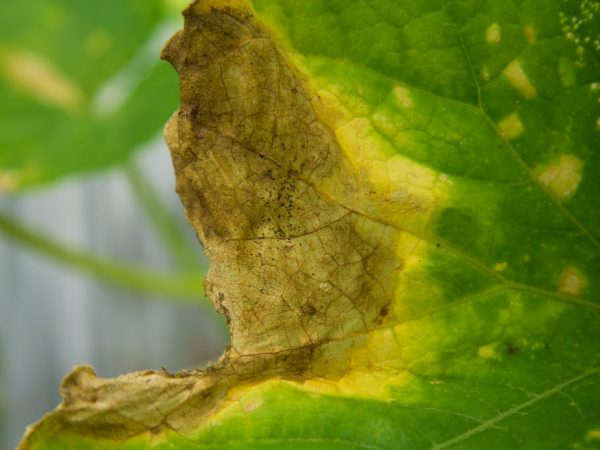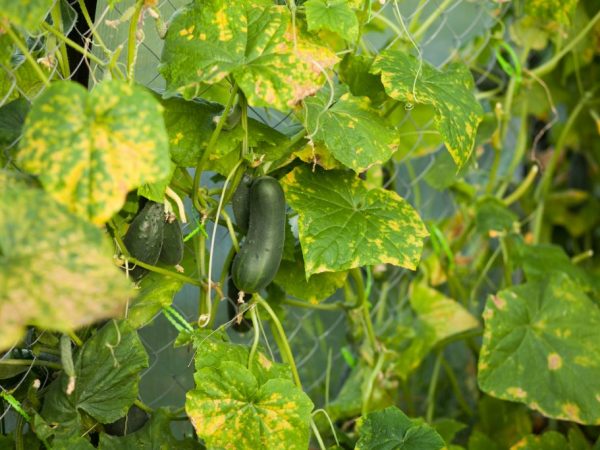Why can cucumbers turn yellow in a greenhouse
Many summer residents who grow cucumbers in a greenhouse are faced with the problem of yellowing and drying of the leaves. In this case, you need to figure out why the cucumbers turn yellow in the greenhouse. There can be many reasons for this: lack of moisture in the soil, lack of sunlight, or various diseases and pests.

Causes of yellowing of cucumbers in the greenhouse
If there is a threat of crop loss, you need to solve the problem immediately, until all the plantings turn yellow. The yellowing of the leaves is a signal, a call for help from a plant. Do not worry if the lower leaves of the plants turn yellow. Basically, the yellow lower leaves are simply removed, without harm to the plant. The rest of the problems must be dealt with.
Temperature changes
Why do cucumbers turn yellow in a greenhouse? Cucumbers love warmth and moisture and cannot tolerate sudden changes in temperature. In an effort to get an early harvest, gardeners try to plant seedlings early, using greenhouses for this. But without heating during frosts, the temperature at night there is only a few degrees higher than outside. Low temperatures can freeze plants. Why else do cucumbers turn yellow in the greenhouse? If during the day under the rays of the sun, the greenhouse heats up very much and the plants there are so hot that they have to open the vents and doors for ventilation, then in this case the embryos dry up, and the edges of the leaves turn yellow and wither over time.
If you steam cucumbers, then they stand like boiled ones and then fall off in a greenhouse. It turns out a big temperature difference and the plants feel uncomfortable. Leaves turn yellow, plants stop growing, and may even die. To protect against night frosts in a greenhouse, gardeners use additional shelters made of film or other covering materials. You can put five-liter water bottles in the greenhouse. During the day they will heat up, and at night they will begin to gradually give off heat, maintaining the optimal temperature. For cucumbers, the ideal temperature is 22-26 degrees. When the temperature rises above 40 degrees or below -14, no nutrition is supplied to the roots, and the plants do not develop.
Lack of nutrition
What to do if embryos wilt with proper and proper care? What causes ovaries or ready-made fruits to fall off? In this case, the problem may be the insufficient nutrition of your plantings. First of all, you should properly prepare the soil for planting. Without the right amount of necessary microelements, there will be no harvest and the nymphs in the greenhouse turn yellow and dry out.
The soil must contain sufficient amounts of nitrogen, magnesium and potassium. The yellowness of the leaves when grown in a greenhouse may indicate a lack of necessary substances in the ground. This is usually due to a nitrogen deficiency. At first, the leaves brighten, and then turn yellow, curl and dry. Subsequently, the whips begin to turn yellow. The lack of nitrogen can also be seen in the hook-shaped fruit.
Top dressing of soil and cucumbers
- In the autumn, when digging the soil, humus is introduced into the soil (2-3 buckets per 1 sq. M).You can add it in the spring before planting seedlings.
- Before planting, the seedlings are fed with fertilizers and sprayed with water with dissolved microelements.
- During the summer, cucumbers are watered with a solution of chicken droppings. Herbal infusion with nettle helps well. Young nettles are finely chopped, put into a container and filled with water. Keep for several days, stirring constantly. The solution is used for watering, adding 0.5 liters to a bucket of water.
- Plants can be fed with urea, in dosage according to the instructions on the package.
- To provide potassium, you can use tree resin or buy the necessary preparations.
By feeding the soil properly, you take care of the harvest.
Moisture deficiency
Cucumbers love moisture and need not only good watering, but also optimal air humidity. If you notice that the cucumbers wilt, and then yellow spots on the leaves fall between them, then this is a sure sign of moisture deficiency. Planting can only be watered with water at ambient temperature. You cannot water with cold water. From cold moisture, or lack of it, the leaves can turn yellow, after which it is quite difficult to restore nutrition in the leaves of the plant.
During the onset of fruiting, watering is increased. Before watering, water must first be defended for 3-4 days. The soil must be moist for plant roots to develop well. Plant health and productivity depend on this. Please note that excessive watering is also harmful. It can cause fungal infections. Watering is necessary next to the root a few centimeters away, trying not to fall on the leaves.
Poor pollination

Lashes may turn yellow without insect access
They try to plant self-pollinating varieties in greenhouses, but they also need pollination. Without this there will be no bountiful harvest. It is necessary to find out if the ovary is not sufficiently pollinated, then from this it may turn yellow. This happens mainly without aerating the greenhouse, and when there is no access for insects to the greenhouse.
Spraying the bushes with a solution of boric acid or special preparations for the ovary will help to correct the situation.
To attract bees, plants are sprayed with sweet water (with sugar or honey) or boron - magnesium fertilizers, which increase the secretion of nectar on the flowers. Can be planted in a greenhouse borago and hyssop. Insects love these honey plants and make their way inside, pollinating the seedlings. Having plucked a male flower, you can pollinate several female buds with it yourself.
Insufficient care
If the embryos of cucumbers in the greenhouse turn yellow, what should I do? With insufficient care, the ovaries of cucumbers in the greenhouse and their fruits also often turn yellow. Many gardeners love cucumbers for their taste and easy care, but it is imperative to follow the schedule of watering, lighting and feeding. Without proper care, it is impossible to grow a strong and healthy crop. In greenhouse conditions, cucumbers develop rapidly and can form many ovaries at once. This overloads the bush and the leaves turn yellow.
If the ovaries are more than the prescribed standard, then yellowing of young set cucumbers, which lacked nutrients, is characteristic.
In this case, you need to pinch the shoots in time. No more than 25 ovaries are left on one bush. This allows the cucumbers to form and ripen. If gardeners leave more ovaries, they will get an ugly yellow fruit. Watering during the day in the heat and moisture on the leaves can provoke a sunburn. Therefore, planting should be watered only in the morning or evening. You need to take care of the plantings carefully. If the roots are damaged during loosening or weeding, the leaves will begin to turn yellow.
Diseases
If the cucumbers in the greenhouse turn yellow for no apparent reason and all the conditions for their growth are met, then it is possible that your plantings were affected by diseases or pests. There are quite a few diseases that the seedlings suffer, and in order to properly prescribe treatment, you need to know the signs of diseases.Landings can be affected by harmful insects and infections. Fungal diseases include:
- Root rot. Plant leaves may turn yellow with root rot disease. Symptoms appear at any stage of development. Root rot develops with sudden changes in temperature during the day and when watered with cold water. Weak plants get sick first. Gradually, through the soil, the disease is getting to other bushes. For prevention, the soil in the greenhouse is treated with Previcur 2 times per season.
- Peronosporosis. This is the name of a disease known as downy mildew. It is provoked by a plentiful ovary, it can appear with thickened plantings and if there are weeds between them. Powdery mildew also appears when there is abundant moisture in the air and in the soil. The excess ovary is cut off, removing the small and weak ones, leaving only the more active and tall ones. The first signs of the disease: yellow and light spots on the leaves and between them. Gradually, the spots become oily and brown. A gray bloom appears on the bottom of the sheet. A plant affected by this disease dies very quickly.
- Powdery mildew is a fungal disease that blocks plant photosynthesis. This disease is very common, often affecting cultivated plants. First, small light spots form on the leaves. Gradually, the spots enlarge and cover the entire surface of the plant. The leaves are covered with a white or red bloom, turn yellow, dry and fall off. In the open field, the disease affects plantings in the same way. If you do not take action, you can lose the entire crop. They fight powdery mildew - fungicides. For the prevention of the disease, varieties that are resistant to the disease are chosen, greenhouses are treated with potassium permanganate and green manganese are planted.
- Fusarium is a dangerous and complex disease. Fusarium blight threatens with crop loss. Landings sprout well and grow quickly, but when an ovary appears, the leaves begin to turn yellow, the whips dry. The fungus that caused the disease prevents nutrients from entering the plant. To combat fusarium, greenhouse varieties are regularly changed. Replace the affected soil and carry out serious processing of the greenhouse.
- With excessive watering, bacteriosis appears. The ovary turns yellow and dries, the resulting fruit becomes covered with plaque, growths and ulcers. In the early stages of the disease, it can be fought with Bordeaux mixture. It quickly stops the development of the disease. Watering is done more moderately so that the soil is moist, but without excess.
- Cucumbers can get sick with excessive fertilization of the soil. Feeding should be done no more than 3 times per season. The first time - after the appearance of the first three leaves, the second time - during flowering, the third time - after the onset of fruiting.
- Viral diseases. If, following all agricultural techniques and the recommendations of specialists for care, feeding and watering, deformation and yellowing of the leaves occur, this may indicate the appearance of a virus. So that the plantings are not bad, you need to detect a viral disease as early as possible. It is impossible to fight the virus.
Harmful insects
If insects make their way into the greenhouse, they can damage your plantings. When, when attacked by pests, cucumbers turn yellow in the greenhouse, what should I do?
- Melon aphid. This insect settles on the leaves from the lower side and between them and sucks juice from the plant. Aphids can be dangerous for planting throughout the growing season.
- Spider mite. The mite braids the inner side of the leaves with cobwebs. They turn white or yellow and dry out. They use drugs against the pest: neoron, fitoverm, actellik and others. Without their use, plants can die.
- Greenhouse whitefly. This harmful insect moves to planting from weeds. For the prevention and control of the pest, weeds are removed in time, all openings in windows and doors are closed. Small nets are put on the air vents. The soil is fertilized with peat and sawdust. Set up insect traps.
If you correctly find out why the ovary of cucumbers turns yellow in the greenhouse, then many problems can be avoided in the future. Follow all the rules for growing plantings, give them moisture, fertilizing, light and heat at the rate, without lack and excess.


